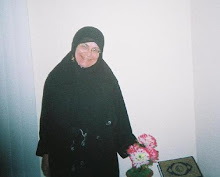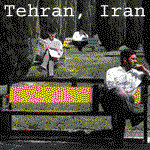The Art of Authentic Forgery
 15 April 2008
15 April 2008By Nadav Shragai
Criminal case 482/04, the State of Israel v. Oded Golan and others, lays out the details of one of the biggest forgery scandals ever in the history of archaeology. According to the indictment, those miseld by Golan, a well-known Tel Aviv antiquities collector, included renowned experts who were ready to confirm the authenticity of the many and controversial findings he supposedly discovered, such as the Jehoash Tablet inscription and an ossuary that supposedly held the bones of James, the brother of Jesus.
And yet, today, three years after the start of the trial, after more than 70 witnesses for the prosecution have taken the stand, and the defense has started to present its arguments, the state prosecutor's office and the Israel Antiquities Authority (IAA), which initiated the indictment, face a problem: Marco Samah Shoukri Ghatas, the Egyptian artist who confessed to manufacturing many items for Golan, including the Jehoash inscription, will not be coming to Israel to testify. According to the IAA, it is the Egyptian authorities that are preventing Ghatas from coming to Israel. Golan's attorney, Lior Bringer, on the other hand, counters that it was the Egyptian's choice not to come.
Either way, the prosecution believes it will win the case even without the testimony of Ghatas, a talented stone artist and jeweler from the Khan al-Khalili market in Cairo. The testimony submitted in an interrogation conducted by the Egyptians and in which he confessed to many of the crimes, has already been cited in the Jerusalem District Court, where the case is being heard by Judge Aharon Farkash. Nevertheless, says an IAA official, "we're very interested in bringing him to Israel, so that the man who by his own admission forged the antiquities for Golan, will say so formally in court."
Ghatas himself spoke openly about the artifacts he manufactured with reporter Bob Simon, on the CBS-TV news program "60 Minutes." And authorities here say they have assured him that if he comes to testify, he will not be arrested.
First Temple tablet
When Haaretz reported over five years ago on the discovery of the Jehoash inscription, the archaeology world was shaken. The inscription, some 10 lines in length, was etched onto a black stone tablet in ancient script. It described the renovation conducted by Judean king Jehoash in the First Temple, as described in 2 Kings 12.
There were immediately doubts about the authenticity of the tablet, and two committees of experts set up by the IAA confirmed the suspicions, concluding that the inscription was indeed a forgery. At the end of 2004, antiquities collector Oded Golan was put on trial. He was accused, along with others, of forging the inscription, as well as fabricating and attempting to sell many other fake antiquities. These included the James Ossuary (supposedly the bone box of Jesus' brother); ancient pottery with inscriptions; a stone menorah attributed by some to the high priest in the Second Temple; a tiny ivory pomegranate, with an inscription, that was thought to be the only existing artifact that had been used in the First Temple, and which was displayed for many years at the Israel Museum. Also determined to be a forgery was a quartz platter with an inscription in an ancient Egyptian language, which ostensibly showed that the ancient city of Megiddo was conquered by a commander of King Shishak. The inscription presumed to solve the question occupying many scholars regarding the identity of the destroyer of Megiddo.
Amir Ganor, who heads the IAA's antiquities theft prevention unit, said in his testimony that Ghatas personally confessed to him that he personally forged the Jehoash inscription, on the basis of the sketches brought to him by Oded Golan. Ganor also reveals that Ghatas admitted forging the handle of the "Menasseh, King of Judah Seal," as well as manufacturing seals and repairing clay pottery and other items according to specifications received from Golan. As for the ossuary of Jesus' brother, James, says Ganor, "Marco admitted only to rinsing and smearing it."
Old friends
Ganor describes the connection between Golan and Marco Ghatas as a close and ongoing one: "This is a relationship that went on for 15 years. At certain times, Marco lived in Oded's home. Marco had an Israeli girlfriend, who testified at the trial, and described his actions. Among the items found in Golan's possession were also crates with various items, on some of which Marco's signature appeared."
The original indictment was issued against five people. Two of them have in the meantime admitted to some of the crimes attributed to them, were dropped from the indictment and became state's witnesses. In addition to Golan, two other accused people remain: Faiz al-Amla, an antiquities trader from the village of Beit Ula in the southern part of the Hebron Hills, and Robert Deutsch, a well-known antiquities dealer from Tel Aviv. The state signed a plea bargain with al-Amla, and he was convicted and sentenced to a six-month jail term.
According to the indictment, in most cases original antiquities were taken, and then fake inscriptions or decorations were added to them, which, if authentic, would have made them extremely valuable. After the items were prepared by this method, they had an artificial patina applied to them. The patina, a layer that accumulates naturally on antiquities over the course of time, was created with great expertise, to the point where many experts were fooled into thinking that the antiquities are indeed authentic. Among the specialists taken in were professionals from the Geological Survey of Israel, in Jerusalem, and experts from archaeology labs and museums in Israel and from around the world.
In the case of the James Ossuary, the indictment alleges that Golan took an ancient ossuary on which was an authentic inscription reading "Ya'akov bar Yosef" (James, son of Joseph), and had added to it the words "ahuei de'Yeshua" (brother of Jesus). The indictment also says that Golan, possibly with assistance, covered up the forgery "by smearing various materials on the ossuary," giving it a patina that would make the entire text appear to have been written during the Second Temple period. Following that, Golan allegedly drummed up publicity for the box, and arranged for it to be displayed at the Royal Ontario Museum, in Toronto, "where it was seen by tens of thousands of people and media from all over the world..."
Expert appraisals
After the forgery process was completed, according to the indictment, the antiquities were given to experts, both for them to verify that the forgery was successful and for them to appraise the importance of the objects. "After receiving an appraisal, attempts were made to sell the items or publicize them worldwide, with the aim of increasing their worth and selling them in the future," the indictment continues.
Among the evidence presented by the prosecution in court: photos and exhibits taken from the labs in Golan's home, where, according to the indictment, the forgeries were made; various sketches and other materials that were used in the preparation of the forgeries.
Lior Bringer, Golan's attorney, says his client denies all the charges attributed to him and stands by the authenticity of the items. "It seems unlikely to me," says Bringer, "that [Ghatas], who was in Israel so many times, encountered trouble coming here to testify. It doesn't seem to me that the Egyptian government prevented him from coming here. What seems more likely is that the man himself prefers, for reasons of his own, not to come to Israel. The antiquities that the Israel Antiquities Authority claims are forgeries - the Jehoash inscription, the ossuary and all the rest, are authentic," says Bringer.














0 Comments:
Post a Comment
<< Home